
Following a two-year collaboration between Triumph and the UK’s electrification experts and a six-month development period, Triumph has unveiled the TE-1 electric motorcycle prototype and released the final prototype test results, which company officials say exceeded the project objectives.
When the TE-1 was unveiled via a video conference call press briefing, it displayed the aggressive stance of semi-naked sportbikes in Triumph’s lineup like the Speed Triple 1200 RS. Prominent features include a twin headlight with what appears to be an angry, furrowed brow and a robust cast-aluminum frame.
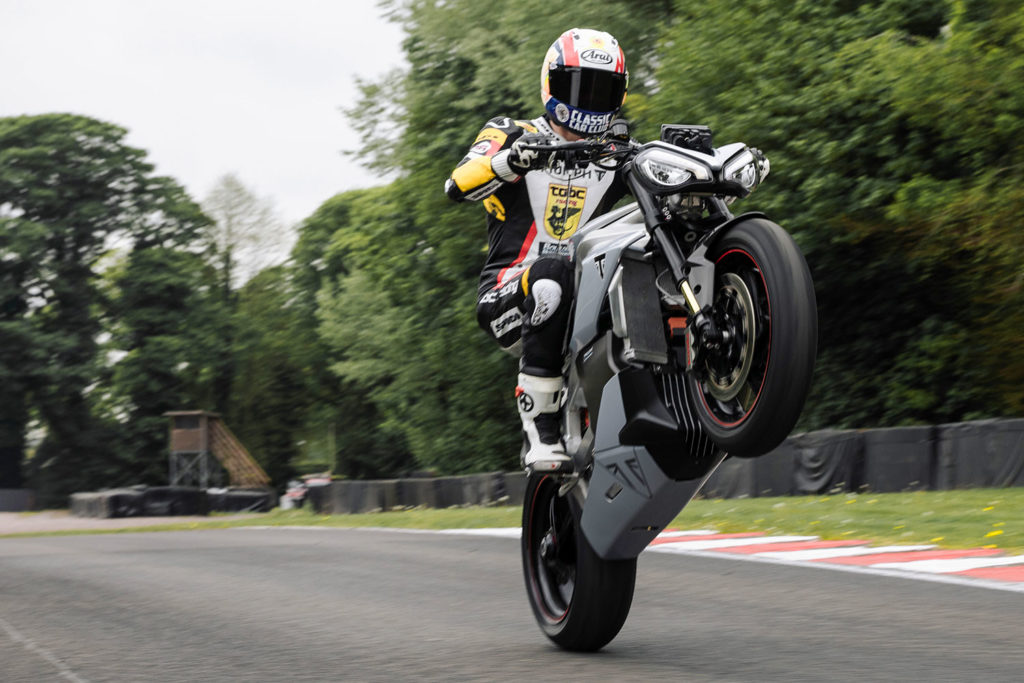
Up front is a 17-inch front wheel wrapped in Pirelli Diablo Supercorsa tires, a pair of superbike-sized brake rotors, Brembo brake calipers, and an inverted fork. Out back is a stout single-sided swingarm suspended by an Öhlins shock.
Behind the front wheel is a large radiator and a peekaboo view of the TE-1’s battery pack, which is mostly hidden behind several panels of racy bodywork. From the humped “tank” cover to the slender, blade-like tailsection, the bike looks like a proper, full-on sportbike – except for the lack of a clutch lever and the belt final drive.
According to a press release accompanying the briefing, the collaboration between Triumph Motorcycles, Williams Advanced Engineering (WAE), Integral Powertrain Ltd, and WMG-University of Warwick was funded by the Office for Zero Emission Vehicles through Innovate UK. It was set up to create “groundbreaking developments in specialist electric motorcycle engineering and innovative integrated technology design.”

The extensive live testing program, which involved assessments of the bike’s performance on both the dyno and the track, provided direction into the final set-up and calibration of the TE-1 prototype, which has now reportedly delivered on all its targets and objectives, setting new standards for the electric motorcycle sector, including battery and range performance.
During the briefing, Miles Perkins, Triumph’s head of brand management, said the TE-1 “very clearly signals the future.”
And with the following specs and features, the future at Triumph looks bright indeed.
Triumph TE-1 Offers 100-Mile Real-world Range
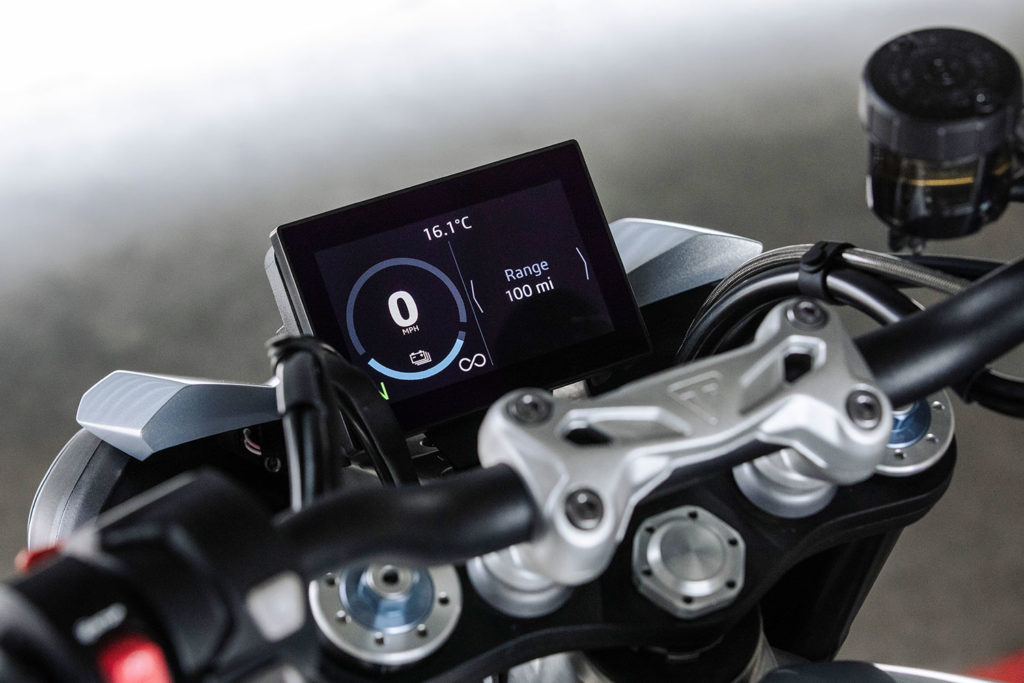
The Triumph TE-1 prototype achieved all project targets with regards to the energy capacity of the WAE TE-1 project developed battery, with a 100-mile (161 km) range, based on official testing and projections.
Regenerative braking has been implemented for TE-1, with scope for further optimization, as well as greater efficiencies in the motor generator unit and transmission, which could improve the range further for the future of Triumph electric motorcycles.
Dyrr Ardash, WAE head of strategic partnerships, said the company is “delighted” to have been involved in the program.
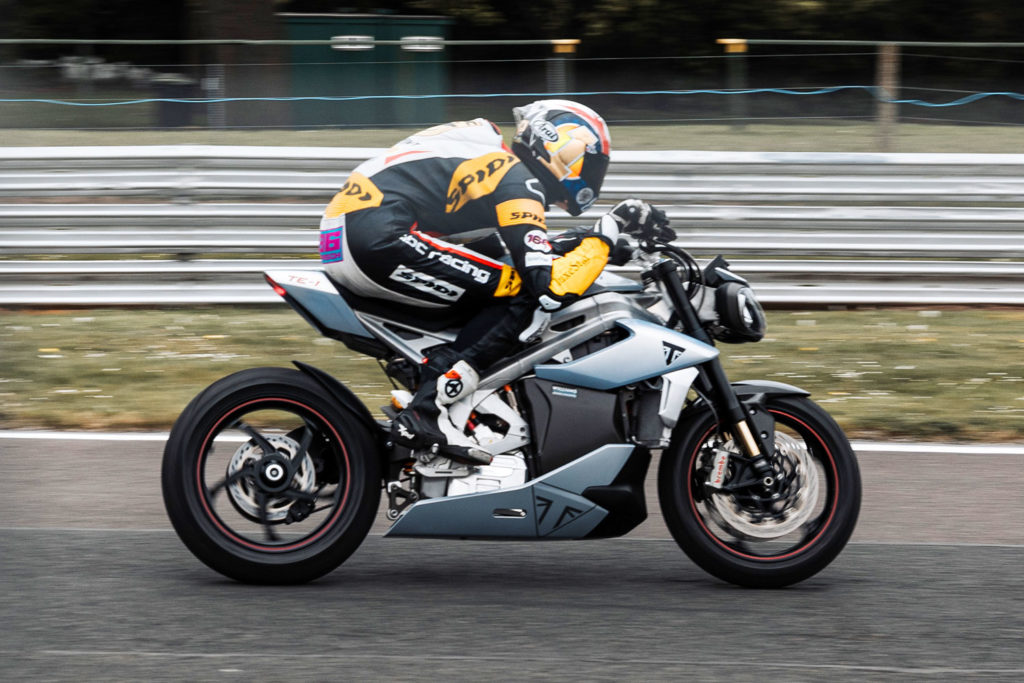
“It is pleasing to hear positive rider comments which confirm that the dynamics of the bike are aligned with Triumph’s DNA,” Ardash said. “This core WAE technology has allowed us to exceed performance and charging targets for the battery which we look forward to seeing in future powertrains.”
Triumph TE-1 Offers Performance That Meets or Exceeds the Speed Triple 1200
During the press briefing, Perkins said the team wanted to ensure the TE-1 “handled like a Triumph,” and the manufacturer’s current Speed Triple 1200 was cited on a few occasions. Along these lines, the TE-1 prototype delivers a claimed 175 hp and 80 lb-ft of torque – very close to the Speed Triple’s figures (177 hp, 92 lb-ft).
The TE-1 has also reported a standing start acceleration of 0-60 mph in 3.6 seconds and 0-100 mph in 6.2 seconds, the latter besting the Speed Triple 1200.
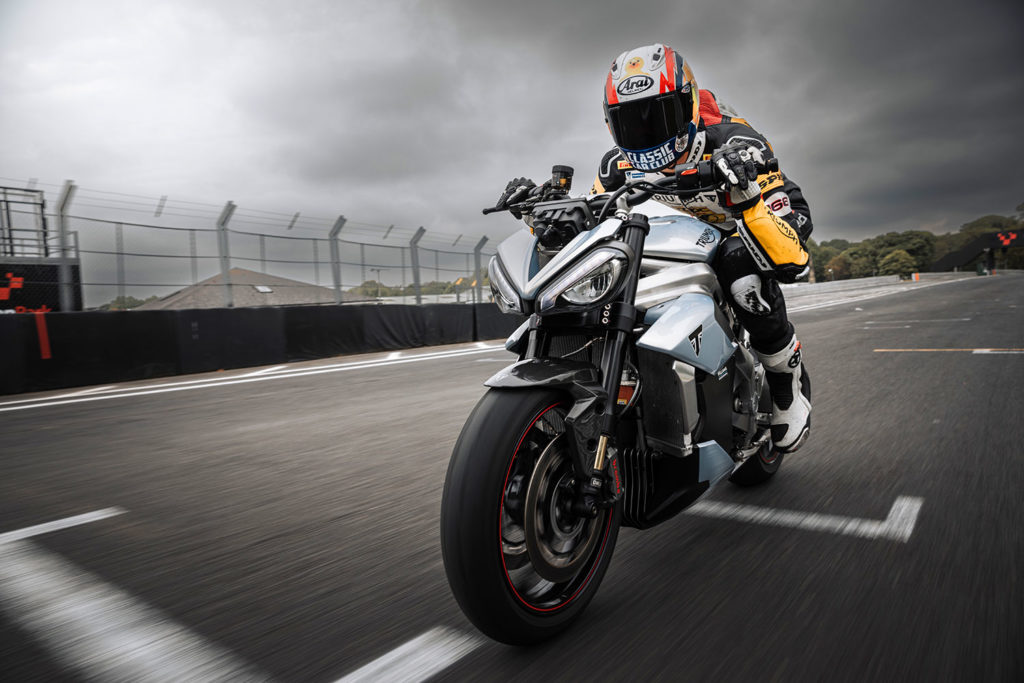
The team responsible for delivering the TE-1 project said they anticipate that performance could be enhanced further with refinement of the electronics, including the traction control system and front wheel lift control.
Daytona 200 champion Brandon Paasch participated in the final testing phase, both in engine performance evaluation and with the final set-up of the prototype through track testing. Paasch called the TE-1’s throttle response “kind of incredible.”
“It’s very torquey and when you first touch the throttle it’s instant power, which is obviously what I love as a motorcycle racer,” he said. “I love when it’s super-torquey and picks up right away, so for me it was a really great experience. I got to peg this thing all the way from zero to 100% throttle and it’s unbelievably quick, it pulls like crazy.”
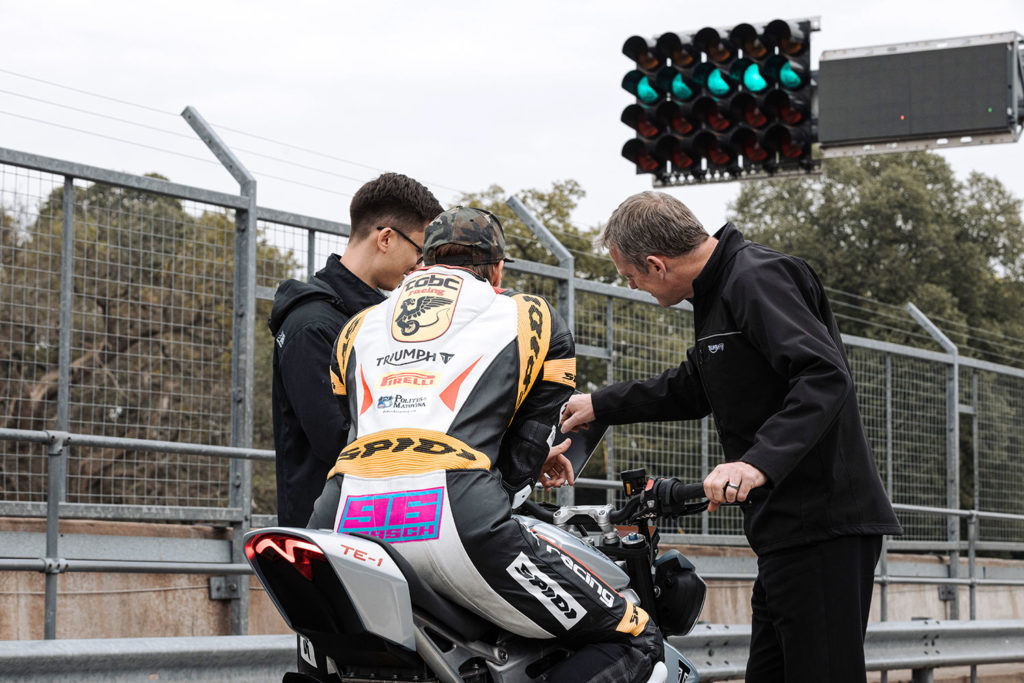
Triumph says the TE-1’s level of performance and acceleration, combined with its riding package, result in a bike that delivers all of the brand’s signature feel and neutral handling: a smooth, predictable ride that is agile and nimble, great in the corners, and provides controllable power.
Professor David Greenwood, CEO of WMG Centre High Value Manufacturing Catapult at the University of Warwick, said motorcycles like the TE-1 “have a pivotal role to play in the transport revolution as a zero-tailpipe emission option.”
“In our partnership with Triumph, WMG used our research experience in electrification to demonstrate manufacturers can deliver products with a lower emission burden as well as outstanding performance-offering customers an EV that is great fun to ride,” Greenwood said.
Triumph TE-1 Boasts 20-Minute Charge Time
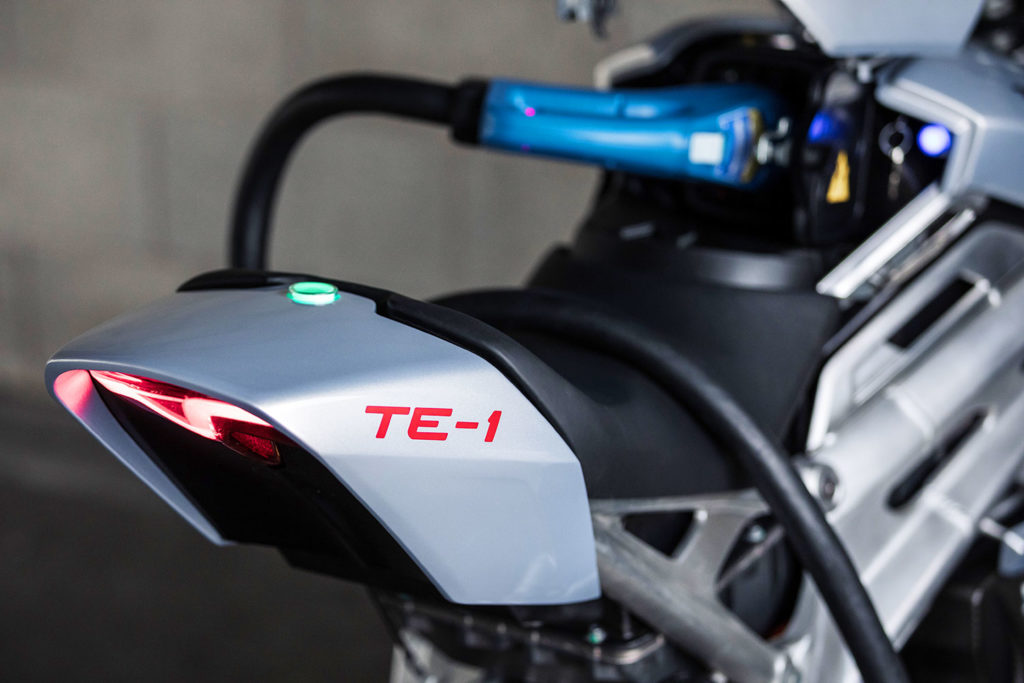
Advances in battery and charging technologies that have been developed as part of the Triumph TE-1 project in collaboration with WAE have resulted in a 20-minute charge time from 0-80%, successfully delivering against the targets laid out by Innovate UK, the government’s research and innovation agency that supports business-led R&D funding and UK business growth.
“We are excited to see that our funding is supporting Triumph Motorcycles in driving forward innovation and capability in the electric motorcycle space, while fostering collaboration between several pioneering UK companies,” said John Bray, R&D lead for the Office for Zero Emission Vehicles. “Investment in Research and Development is key to our mission of putting the UK at the forefront of the design, manufacture and use of zero emission vehicles.”
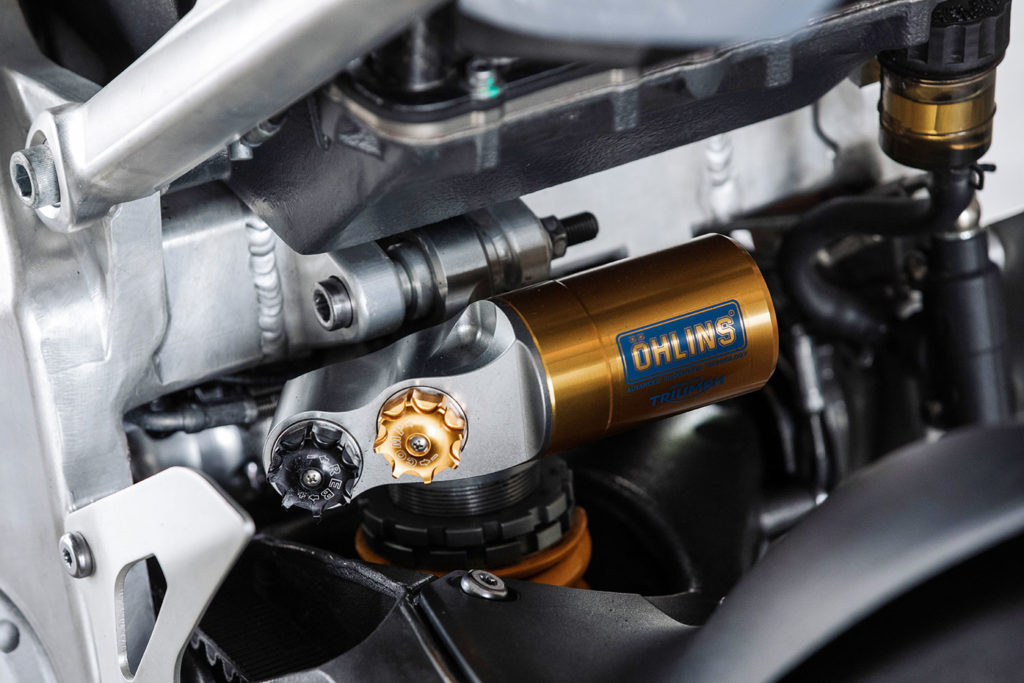
Triumph TE-1 Weighs Less Than Other Electric Sportbikes
With an overall weight of 485 lb, the TE-1 prototype is up to 25% lighter than the equivalent electric bikes available currently, giving it an appealing power-to-weight ratio. Triumph says the bike has a physical size and scale comparable to a Street Triple but with the ergonomics, geometry, and weight distribution of a Speed Triple, while still being nimble and compact.
“I wish I’d had this at Daytona,” Paasch said. “That acceleration in this chassis, and how it corners – wow! I think this would be a really nice motorcycle to ride on the street, just based on how nimble and agile it is, and how light it feels.”

A New Electric Soundtrack That Builds to a Crescendo
Described in the press release as a “distinctive and thrilling soundtrack, building to the most spine-tingling crescendo,” the Triumph TE-1 prototype’s sound is considered by company officials to be more appealing and exciting than any of the equivalent electric motorcycles currently available thanks to its unique helical gear pair primary transmission.
At the briefing, Perkins said it has “much more like a jet turbine sound.”
What’s Next?
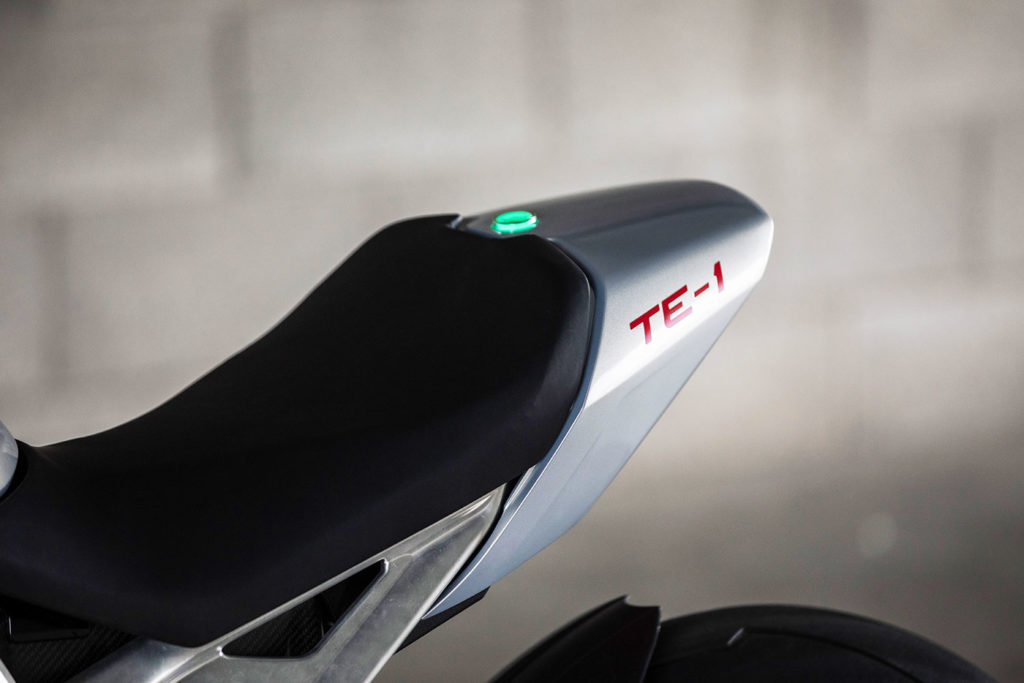
During the press briefing, Triumph Chief Product Officer Steve Sargent called the prototype a “engineering exercise” and didn’t offer a timeline or potential price point for when the average consumer might throw a leg over their own TE-1.
However, in the press release, Sargent said they have already seen “incredibly positive reaction” to the TE-1 prototype from motorcyclists all around the world.”
“Many people are telling us that for the first time, they are seeing an electric motorcycle as desirable, and something that they would genuinely want to own,” Sargent said. “Being the first step in our journey towards developing our future approach to electric powertrain technology, the TE-1 prototype and the incredible results it has achieved in its intensive testing program has provided crucial insights and capabilities that will ultimately guide our future development.”
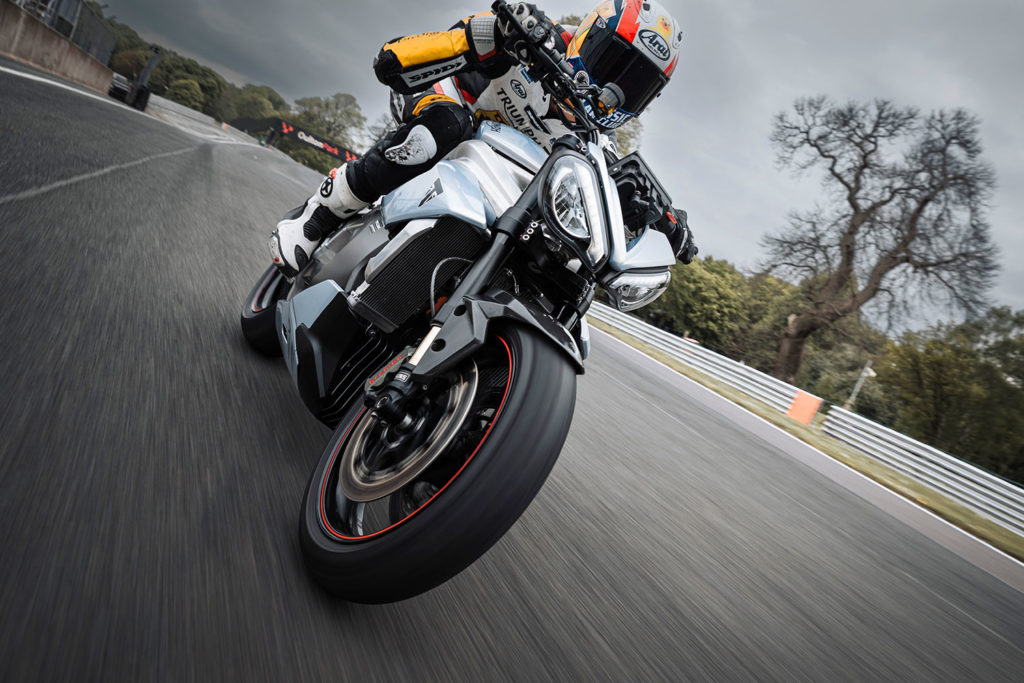
According to the press release, the key objective of the TE-1 project has always been focused on developing electric motorcycle capability, to provide an input into Triumph’s future electric motorcycle offering, driving innovation, capability, and new intellectual property, and enhancing the credibility and profile of British industry and design.
The achievements in the live testing phase, exceeding current benchmarks and targets, provide a platform at Triumph with great potential for future development in electric motorcycle performance.
“We are incredibly proud to be able to share such positive outcomes from the completion of Project Triumph TE1,” said Triumph CEO Nick Bloor. “Everyone on the team is thrilled with the results we have achieved with our partners, and how the outcomes of the project will feed into the electric future to come from Triumph.”

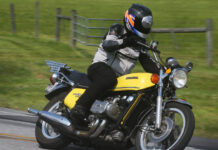
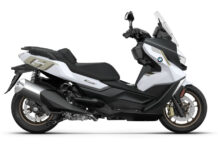
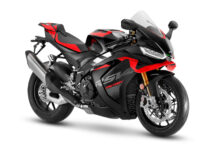





It looks and sounds bike an amazing bike. I will admit to being a little disappointed with the specs. For the average enthusiast looking to buy their first electric MC, the range and price are the 2 biggest factors, everything else is secondary. When all that secondary stuff is only “par for the course” compared to the other brands that have already achieved most of the same specs….it feels a little lackluster, especially since it’s just a prototype. Triumph would have to mass produce this and price it at $20K (or less) to even compete with what is already on the market for $22K (Harley Live Wire, Zero SR/F and Energica Rebelle). I wish them the best of luck and hope they accelerate their progress ASAP.
I really like what they’ve done with these coal-powered motorcycles. It’s amazing.
Where I live, about 85% of electrical power comes from hydroelectric… but point taken.
22% of US electricity production is coal. In California, the largest single market for heavyweight motorcycles in the world, coal is less than 1%. Even if it was 100% there would be fewer emissions per mile travelled because of the efficiency of electric motors and power generation. And since you’re obviously concerned about the effect of coal for power generation, you should support policies and the political party that wants to completely eliminate fossil fuels from our economy.
#stopFUD
Great performance stats, but there is no mention of its range. 75 miles urban and 60 freeway?
100-mile range, testing has only been done on the track so far.
All battery vehicles are rubbish
Who set these Project Targets: the Racing Manager??? WTF! 100mile range? Most commutes and Sunday strolls are longer than that! Come-on Folks, Live in the REAL WORLD!
A 485 LBS Top Heavy looking Beast : looks great on the Track and TOTALLY Impractical except for KILLING a FEW more brainless (literally, after crashing!) id—ts with too much money and too little skill. Great Marketing!
I’d like a Electric w 3-wheels: 2-in-front-Fat in back, a low center of gravity, low seat height, 300mile Range, under 400 lbs and under 20k pls.. Geez you’d think the snow-folks had done already!
> 100mile range? Most commutes and Sunday strolls are longer than that!
“Most commutes” are more than 100 miles round-trip? I think not!
Mind you, most folks are not going to buy something like a $30,000(?) motorcycle just for commuting. When Honda or Yamaha make a motorbike with the specs of a Honda Cub (and for a reasonably-comparable price point), maybe then I’ll take this electric stuff seriously.
@gman1954 100 miles a day? How is that possible? If there are 225 workdays a year that means the average American car gets driven 225,000 miles a year. Instead, it’s about 14,000. How are these people getting to work? Teleportation? Autogiros? Human cannonballs?
Check your math, Gabe. 100 x 225 = 22,500
Check out the Aptera vehicle! All your specs but weight.
Until they get the range up to about 250 miles these bikes are going to be a tough sell because this one in particular is not your average city commuter but more of an all day Sunday ride.
As a Triumph owner, I would concur with the other bike owners on the cost, range issues associated with Ebikes. It doesn’t appeal to me, it’s a niche market.
I agree with the other comment, It has to have a range of at least 250 mi.. That only 125 mi. one way. I live in the west and most riders ride the back roads. There are no recharge stations on these roads. Maybe someday you’ll have recharge stations on these roads, but it will a long time before this happens. The weight is to high. I do not understand why the designers think a bike has to be will over 400 lbs.. My GP bike was only 300 lbs. and was stable at all speeds.
It’s all smoke and mirrors until they have it on the market.
That being said, anyone who hasn’t actually ridden an electric motorcycle, is just talking out of their butts.
Looks definitely hopeful, reasonably practical. That claimed 20 minute charge time does a lot towards making up for the 100 mile range . . . . . however . . . . . they conveniently don’t mention what level charger and what output rate is needed to match those specs. I’m assuming DC Fast Charging (aka, Level 3) but I seriously wonder if you’d get that spec out of what are the usual 50kw chargers I occasionally use on my Bolt. I’d be curious to find out what the needed time is on the usual 30amp home Level 2 setup.
Obviously, it does appeal to me, as I’ve been using an EV as my daily four wheeled transportation very nicely for the past couple of years. 100 mile range isn’t necessarily that bad a setup, as I’m looking at the riding position as nothing that this 72 year old body would want to wrap itself around for long distances (my current rides are: 95 Triumph Sprint, 11 Harley Electra Glide, 85 Cagiva Alazzurra).
As to lack of chargers, that’ll be changed quite a bit by the time the first production model hits the showroom floors.
Not for me! 100 mile range…and then a 20-30 minute charge time??? Imagine having to waiti at a gas station…ion line or not…and then take 20+ minutes to fill your tank! Not practical in any way…no matter how one looks at it! They did get the “insect-looking”…current market look right…but at this point I’d say it would not be a sales success in the market.
The 100 mile range is with a full battery. The 20-30 charge is only to 80% the last 20% takes almost as long as the first 80%. They won’t tell you what the 80% range is. Look up how LION batteries take a charge.
And that’s why EVs will not sale to the general public. They are so proud to have a 100 mile range and 20 minutes charge time to 80%.
When a battery electric motorcycle can get 220 miles of range and can charge to 90% in 15 minutes and a battery electric car can get 500 mile range and charge to 90% in 20 minutes and both cost about the same as a compairable ICE vehicle then maybe the general public will start moving toward electric on their own without Government mandates.
But that said. That is a cool bike.
If you want to know the price of an electric motorcycle, get the price of an ICE motorcycle with equivalent performance and specs… and then multiple that by a factor of three.
Maybe with mass production and scaling, the prices will come down to something reasonable – but I’m not going to hold my breath while I wait.
While battery technology has advanced it is still 15 to 20 years away from what is needed in the REAL world. When you can ride 350+ miles at highway speeds & then charge to 100% in 30 minutes off of a 120 Volt 20 Amp power source an Electric motorcycle is just a novelty. They don’t tell you that charging from 80% to 100% takes as long or longer than from 10 to 80%. Do you only fill your gas tank to 80% ?
500mi for an electric car? Most ICE vehicles get 300mi or less on an tank. You guys are full of it. Its a prototype that shows it can roll like a full on race bike. Handling is more important the range any day.
Good sensible comparative overview.
https://interestingengineering.com/science/clean-evs-and-dirty-lithium-mining-business
I used to have a daily commute that varied from 60 miles to 115 miles ONE WAY! Battery bike would never suit my needs.
If someone has a commute that is longer than 20 miles, I am sorry for that person. What a shitty commute. I wouldn’t ever work in any place farther than 12-15 miles. Anything more than that is just self-punishment. I use an electric scooter already. It has about 60 miles of range. I recharge it every 3 days during the night. Not a problem.
Range is not a real problem on electric vehicles, range is a spec benchmark that people exaggerate in their minds. How many times a does person travel more than 100 miles on a daily basis? I do it about 4-6 times a year, and I don’t know anyone that does it more.
The problem is more about infrastructure. If in North America we could have decent trains, we wouldn’t be concerned about traveling long distances by car. If we would have decent public transportations in our cities, that wouldn’t even be a discussion.
The key for electric vehicles is battery efficiency and charging infrastructure. Once those things are solved, there is no need for cars with more than 250 miles range and motorcycles with more than 150 miles range.
my e bike keeps up with traffic and goes further than the te (hee) 1, and costs a lot less.
will stick to petrol and noise until the hydrogen cell market opens up.
PS. don’t forget its not 100 miles its only 50, if you want to get home again. 50 there 50 back.